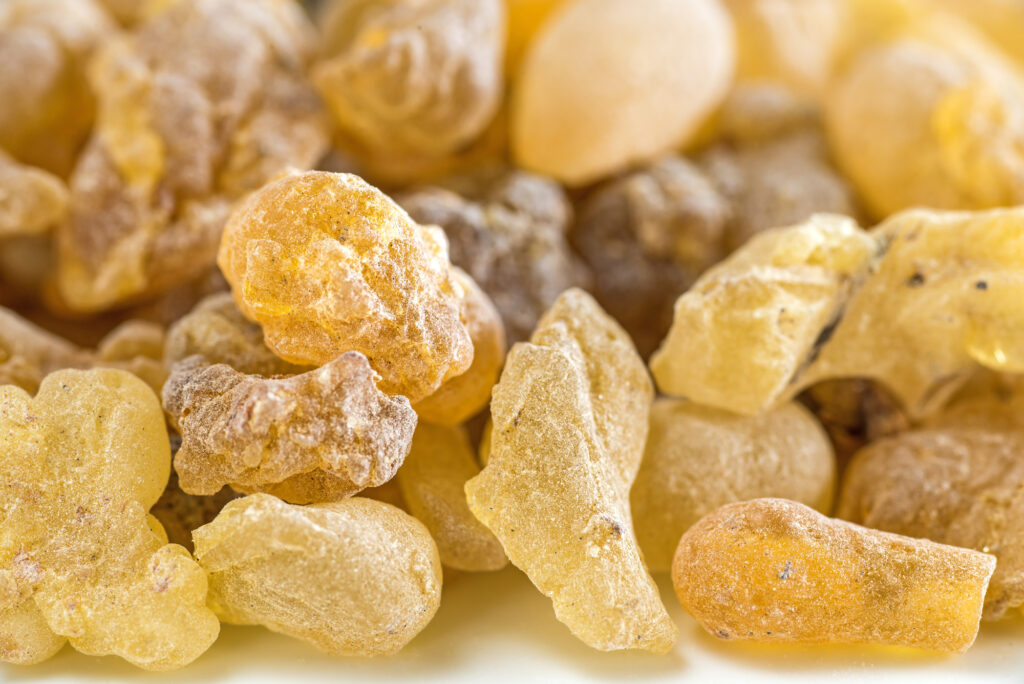Boswellia serrata, known more commonly as frankincense, is a branching tree native to India and Pakistan. Its resin has been used for centuries in religious ceremonies, but it is more prized for its medicinal properties. In the ancient Indian healing tradition of Ayurveda, extracts of Boswellia were used to treat a variety of inflammatory conditions ranging from arthritis to cancer. And modern researchers have confirmed its benefits as an antiarthritic and anti-inflammatory compound. Most interesting, however, may be its potential to act as an alternative to opioids and other addictive drugs in the area of pain relief.
Study Highlights
Numerous studies have shown Boswellia to be an effective pain reliever, especially in cases of joint pain associated with arthritis. A 2020 research review published in BMC Complementary Medicine and Therapies that evaluated seven randomized clinical trials involving 545 osteoarthritis (OA) patients found that the herb may help relieve pain and stiffness and improve joint function and concluded that “Boswellia and its extract may be an effective and safe treatment option for patients with OA.”
Not surprisingly, based on its origin and history, many of the best studies on Boswellia come from India. A 2010 study, for example, published in the International Journal of Medical Sciences, tested two different proprietary Boswellia preparations—5-Loxin® and Aflapin®. Researchers recruited 60 OA patients and randomized them into groups that received either 100 mg 5-Loxin®, 100 mg Aflapin®, or a placebo daily for three months. Each patient was evaluated for pain by a visual analog scale (VAS), Lequesne’s Functional Index (LFI), and the Western Ontario and McMaster Universities Osteoarthritis Index (WOMAC) at the baseline and then on days 7, 30, 60, and 90.
“At the end of the study,” the researchers wrote in their conclusion, “both 5-Loxin® and Aflapin® conferred clinically and statistically significant improvements in pain scores and physical function scores in OA subjects. Interestingly, significant improvements in pain score and functional ability were recorded as early as 7 days after initiation of the study in the treatment group supplemented with 100 mg Aflapin®,” and that, “Aflapin® exhibited better efficacy compared to 5-Loxin®.” They also concluded that both formulations were safe for human consumption.
That conclusion was reinforced by a 2011 double-blind placebo-controlled study of 60 more OA patients that was published in the International Journal of Medical Sciences. The subjects were divided into two groups and given either 100 mg of Aflapin® per day or a placebo for one month. Participants were again evaluated for pain and physical functions with the VAS, LFI, and WOMAC tools, this time at baseline and on days 5, 15, and 30.
At the end of the 30-day trial period, the researchers wrote, “The observations suggest that Aflapin® conferred clinically and statistically significant improvements in pain scores and physical function scores in OA subjects. Aflapin® provided significant improvements in pain score and functional ability in as early as 5 days of treatment. In conclusion, our observations suggest that Aflapin® is a safe, fast-acting, and effective alternative intervention in the management of OA.”
More recently, a 2022 study tested 100 mg of Aflapin® against a placebo and achieved similar results. In this case, 70 subjects with OA of the knee were recruited to participate in a 30-day randomized, placebo-controlled clinical trial. Patients were again evaluated for pain and function using the VAS, LFI, and WOMAC tools at baseline and on days 5 and 30.
Sixty-seven patients completed the study, and once again, those in the Aflapin® group showed significant improvements in pain scores within five days of treatment. At the end of the trial, the Aflapin® group’s pain scores on the three tests decreased by 45%, 40.9%, and 44.4%, respectively. “This investigation affirms that Aflapin® is clinically efficacious, fast-acting, and safe in the management of osteoarthritis. No significant adverse effects were observed.”
Conclusions
While more—and larger—clinical trials are needed to evaluate Boswellia before it can become a frontline treatment for pain, these studies and others prove that it holds significant promise. As America deals with an ongoing crisis driven by addiction to opioids and other pain relievers, natural solutions such as Boswellia may hold the key to a healthier, pain-free future.
READ THE FULL STUDIES:





